As hikers, mountain bike riders and outdoor enthusiasts stretch their legs on the newly opened and much anticipated Wangetti Trail (Stage 1) in far north Queensland, Principal Contractors, Wagners Composite Fibre Technologies (CFT) reflect on technical aspects of the project build.
Wangetti Trail is a $47 million ambitious ecotourism project set to showcase one of Australia’s finest World Heritage areas, three national parks and the traditional lands of the Djabugay Nation over 94 kilometres of trails from Palm Cove to Port Douglas.
The first 7.4-kilometre section of purpose-built dual use walking and mountain biking trail was opened to the public late September from Palm Cove Jetty to Ellis Beach and is the only trail of its kind in Australia.
Wagners CFT Project Manager, Daniel Allen said the Wangetti Trail build has been a very challenging project but an extremely rewarding one.
“Probably the greatest challenge we experienced as project managers on Wangetti was just the weather. We started the build in July 2023 and while we’ve worked in more remote project sites the steep terrain and dense rainforests certainly threw out some challenges,” Daniel Allen said.
“But in December 2023, just five months into the build, the site was subjected to far north Queensland’s wettest tropical cyclone on record; dumping more than 2-metres of rain on the work site and with destructive winds of up to 270 kilometres an hour,” Mr Allen said.
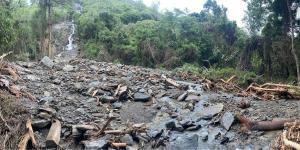
Pictured – A rubble landslide along Wangetti Trail following Cyclone Jasper which dumped 2-metres of water onsite and gusts up to 270 kilometres an hour.
“So, the first 1.4 kilometres of trail we had just constructed was severely impacted and we had to start again. Unfortunately, that put our work schedule two months behind where we would have liked to have been entering the region’s traditional wet season between December to February so for the next three months, we really had to maximise those windows of good weather and dodge the bad weather,” he said.
“Across the 14-month project build for Stage 1 we had more than 4 metres of rain on site. There were some really great learnings we did take from that one in two-hundred-and-fifty-year storm which enabled us to apply those learning to the trail and make it more resilient.”
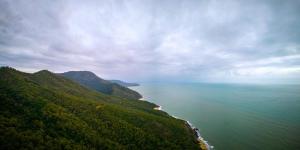
Pictured – Wangetti Trail is an ambitious ecotourism project set to showcase one of Australia’s finest World Heritage areas, three national parks and traditional lands of the Djabugay Nation.
Wagners CFT Project Engineer, Matthew Weise explained in the face of challenging weather, one of the major advantages the team had was utilising the lightweight and modular nature of Fibre Reinforced Polymer (FRP).
“Getting the project back on track following Jasper and really doubling down on speed of construction was made possible through the selection of FRP for the 18 pedestrian bridges within the first section of the trail,” Matthew Weise said.
“These bridges ranged from 6 metres to 16.4 metres long but because FRP is lightweight that enabled us to safely lift by helicopter all the profiles directly to site and then man handle them without the need for large machinery,” Mr Weise said.
“Because FRP is modular by design, once the profiles were onsite, it was really a case of bolting it all together; so pretty much from lift to completed bridge was about a week for each of the 18 bridges which is really fast and allowed us to work within those windows of good weather,” he said.
“Logistically it was very regimented though; first we had to cut a trail to the bridge sites, then excavate the soil for the bridge foundations; where required arborists would climb the trees and trim any small branches to allow the bridge to be lifted in via the canopy by helicopter and then on the actual day we had to hope for good weather and for it to not be too gusty.”
“We coordinated more than 175 helicopter flying hours over 1,375 lifts with an average of 450 kilograms per lift. That’s more than 600 tonnes moved during the project with helicopters.”
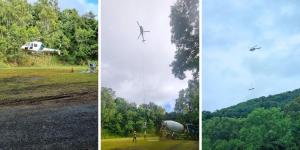
Pictured – More than 600 tonnes of material was heli-lifted onto site during Stage 1 of the Wangetti Trail.
In addition to the bridges, the team also constructed earth cut trails, rock walls, rock matting and heavy rock armour trails.
“The terrain itself was quite challenging and it changed quite drastically over the first 7 kilometres of the trail from drier more open sections of forest to dense thick lush rainforest, then back to open drier forests again,” Matthew Weise said.
“It really was pretty harsh terrain working on the side of a steep hill with high cross slopes, so it was very challenging to cut in,” Mr Weise said.
“There were amazing views though once you climb to the top of the trail it looks out to Cairns and Yarrabah then back to Port Douglas and Ellis Beach; it’s a stunning beautiful part of the world,” he said.
Traditional Owner groups played a major role in the planning and execution of Stage 1 of the Wangetti Trail with Caring for Country Officers were present for the protection of cultural heritage during construction.
“It was great to have Traditional Owners on the build with us and it was great to see what huge respect they have for the land we were working on together,” Daniel Allen said.
“And they were really willing to share their knowledge of the area and explain their stories to us; they were fantastic at advising our team of the bigger scope; because they’re families had walked this area down to the beach for thousands of years and so their connection and understanding was really deep and measured,” Mr Allen said.
“Several First Nations people were able to further enhance their skill set during the build with formal construction training too so that was a valuable part of the project to invest back into the community for long-term career prospects within the construction industry or even long-term care and maintenance of the trail itself,” he said.
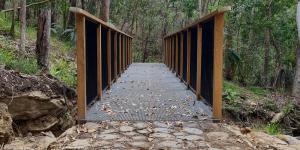
Pictured – The lightweight, modular nature of FRP made it the ideal material to heli-lift into remote and hard to reach places along the Wangetti Trail.
One of the great success stories of the project as well was engagement and communication with stakeholders.
“We had a lot of stakeholders who were very passionate about this project from the State and Federal Government funding providers, Queensland Parks & Wildlife Services, to local Councils plus Traditional Owners, local businesses, and mountain biking and other community groups,” Daniel Allen said.
“We really employed a site-based collaborative approach to the project starting from walking the entire trail together before we even started any work; so we could really understand everyone’s views and needs from the project,” Mr Allen said.
“We regularly had key stakeholders on site for progress updates, face to face meetings and any visitors who wanted to come and see what was happening we happily welcomed and gave them a tour of the site,” he said.
“If there was a problem we would come together to resolve it and being close with the project team we were really able to troubleshoot issues together and move forward quickly.”
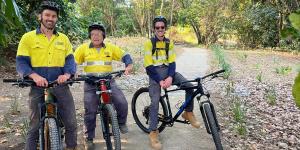
Pictured (L-R) – Wagners CFT General Manager AU/NZ Ryan Leeson, Senior Project Engineer Ernesto Coelho and Project Engineer Matthew Weise saddling up to trial Stage 1 of Wangetti Trail.
The Queensland government has recently announced that trail builders will soon be back to work on Stage 2, which stretches a further 25 kilometres to Wangetti, crossing the Macalister Range National Park and Wet Tropics World Heritage Area and featuring a public camping site.
They say the second section is currently undergoing an alignment review following the impact of ex-Tropical Cyclone Jasper, with design and approval to progress through 2024 and construction to start in early 2025 and take 12-18 months.
After that, the 54 kilometre Wangetti North section will be built from Wangetti to Mowbray River, followed by the final 7 kilometre stretch from Mowbray North to Port Douglas.
The government says the full 94 kilometre trail is expected to be completed by 2026 and will attract thousands of new visitors to the region, injecting up to $390 million into the economy over its lifespan.
It will support the growth of existing industries like tourism, hospitality, accommodation and transport with commercial opportunities to be fully explored over the next 12 months; this could include bike hire, transportation, guided walks or bike rides, dedicated on trail accommodation and other ecotourism experiences.
For those planning on walking the trail, the first stage is rated Grade 3 – suitable for most ages and fitness levels, with a few sharp turns and steep narrow sections.
A one-way journey will take roughly three hours for hikers and 45 minutes for mountain bike riders, with hikers having right of way on the two-way, shared track.
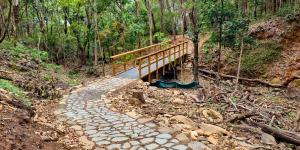
Pictured – A total of 18 FRP bridges from 6 metres to 16.4 metres were installed in Stage 1 of Wangetti Trail.
For more information on Wangetti Trail visit https://www.dts.qld.gov.au/tourism/qld-ecotourism-trails/wangetti-trail
For more details on Wagners CFT FRP pedestrian infrastructure visit https://www.wagnerscft.com.au/solutions/pedestrian-infrastructure/
The Queensland Government is delivering the $47.1 million Wangetti Trail in Tropical North queensland, which includes additional investment of $8 million from the Australian Government’s National Tourism Icons Program.


